
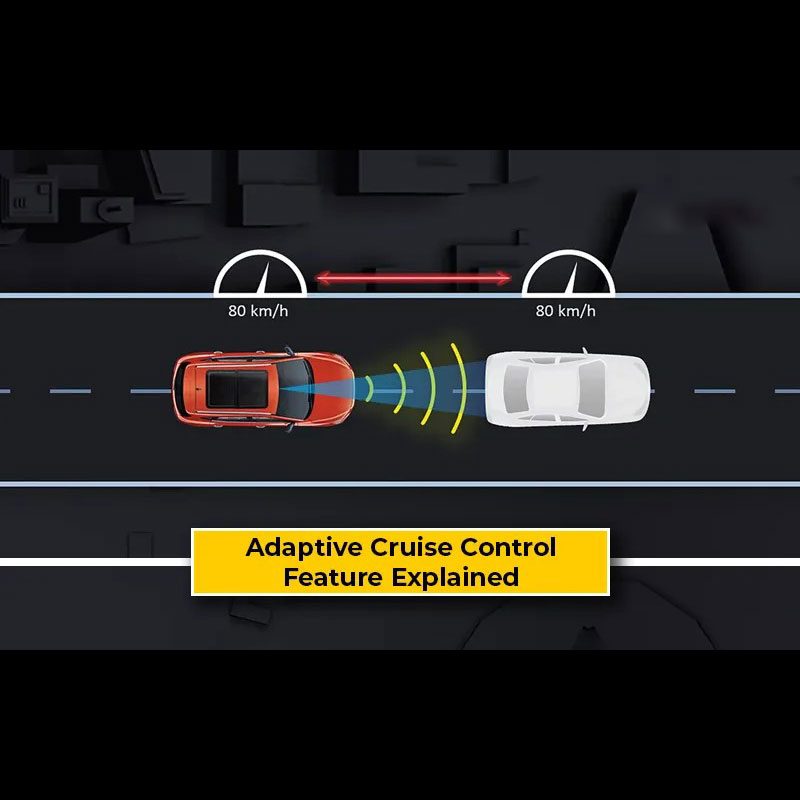
Adaptive Cruise Control (ACC) is a modern driving aid that combines convenience and safety by automatically maintaining a set speed and adjusting it based on the distance to the vehicle ahead. As advanced driver assistance systems (ADAS) become more prevalent in today’s vehicles, ACC is quickly becoming a must-have feature for many drivers.
In this guide, we’ll explain what adaptive cruise control is, how it works, how it differs from standard cruise control, the technology behind it, pros and cons, common issues, and whether it’s worth it for your next car.
Table of Contents
ToggleAdaptive Cruise Control (ACC) is an advanced version of cruise control that not only keeps your car at a set speed but also adjusts that speed automatically to maintain a safe following distance from the car ahead.
Imagine driving on the highway. You set your speed to 65 mph. A slower vehicle merges in front of you. With traditional cruise control, you’d have to hit the brake. But with ACC, your car automatically slows down to match the vehicle’s speed—and then speeds back up when the road is clear.
This makes long-distance and stop-and-go driving more comfortable and significantly reduces driver fatigue.
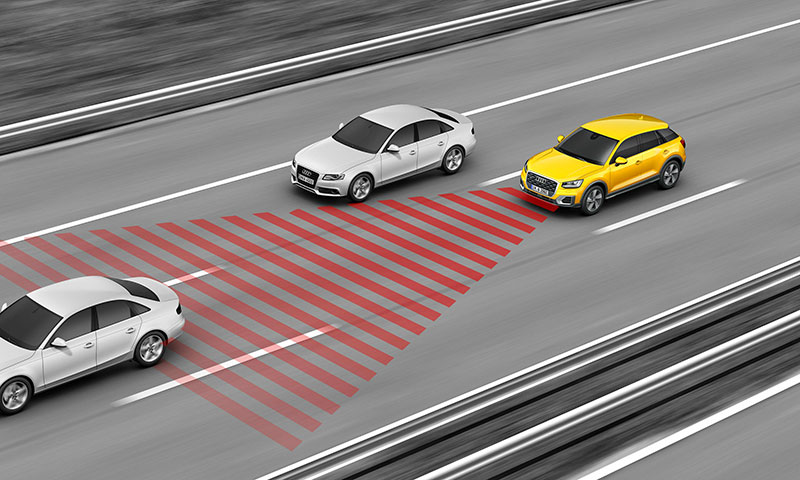
Speed Maintenance: Keeps a constant speed like traditional cruise control.
Distance Control: Maintains a safe gap from the vehicle in front.
Automatic Braking/Acceleration: Slows down or speeds up based on traffic flow.
Driver Override: The driver can take back control at any time by pressing the brake or accelerator.
=> Watch more about its function here:
Depending on the vehicle manufacturer, ACC may also go by other names, such as:
“Distronic Plus” (Mercedes-Benz)
“Dynamic Radar Cruise Control” (Toyota/Lexus)
“Adaptive Cruise Assist” (Audi)
“Super Cruise” or “BlueCruise” (GM/Ford)
While adaptive cruise control is not a fully autonomous driving system, it is a foundational technology behind the future of self-driving cars. It’s a brilliant example of how modern vehicles are becoming more intelligent and responsive—making driving easier, safer, and more enjoyable.
Today, most manufacturers offer ACC in mid-to-high trim levels or as part of a safety package.
Toyota: Toyota Safety Sense (TSS)
Honda: Honda Sensing
Ford: Co-Pilot360
Mercedes-Benz: DISTRONIC Plus
BMW: Active Cruise Control with Stop & Go
Tesla: Included in Autopilot
Hyundai/Kia: Smart Cruise Control
Even economy cars like the Toyota Corolla, Hyundai Elantra, and Honda Civic now offer ACC as standard or optional.
Adaptive Cruise Control (ACC) might feel like magic when you’re behind the wheel—but under the hood, it’s powered by a precise mix of hardware components and intelligent software. Together, these systems create a real-time feedback loop that allows your vehicle to “see” the road ahead, make decisions, and react—without any input from your feet.
Let’s dive into the key components and technologies that make adaptive cruise control possible.
Radar (short for Radio Detection and Ranging) is the backbone of most ACC systems. Mounted in the front grille or bumper, these sensors:
Emit electromagnetic waves that bounce off objects ahead.
Measure how long it takes for the waves to return.
Calculate the distance, angle, and relative speed of the vehicle in front.
Most ACC systems use millimeter-wave radar (typically 76–81 GHz), which offers long-range detection and performs well in poor visibility conditions like fog, rain, or darkness.
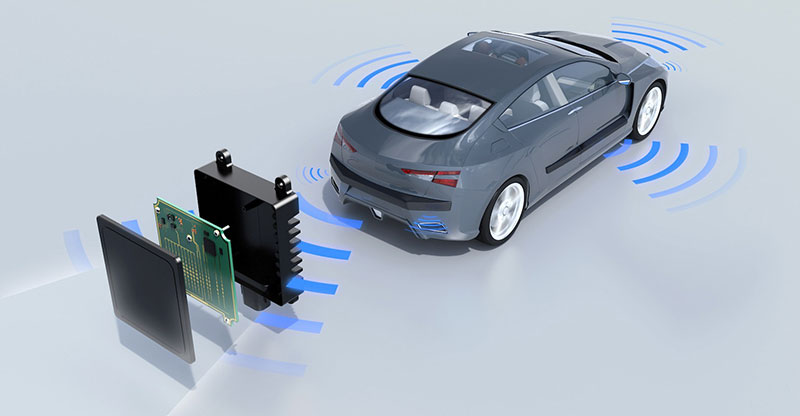
Mounted behind the windshield near the rearview mirror, forward-facing cameras visually identify vehicles, lane markings, traffic signs, and sometimes pedestrians.
While radar gives raw distance and speed data, cameras provide context—they can detect shapes and differentiate between a car, motorcycle, or even a guardrail. This is especially important when deciding whether to slow down or ignore an object.
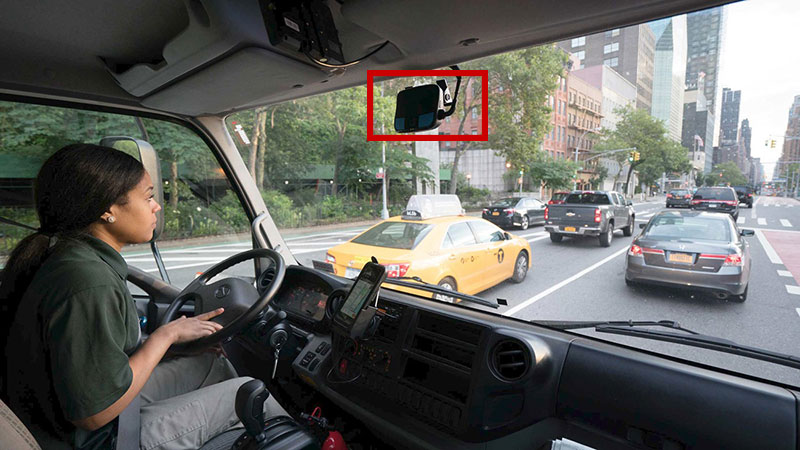
The ECU acts as the “brain” of the ACC system. It receives input from the radar and camera, then processes that data using advanced algorithms to:
Detect objects ahead.
Estimate traffic flow.
Determine appropriate acceleration or braking.
Maintain a consistent, safe following distance.
In modern cars, the ACC software is often part of a larger ADAS (Advanced Driver Assistance System) module, which integrates with braking, throttle, and steering systems.
To control speed autonomously, the ACC system communicates with:
Electronic throttle control: Adjusts engine power to accelerate or decelerate.
Brake actuators: Apply light braking pressure to reduce speed smoothly when approaching slower traffic.
This interaction allows the vehicle to slow down or speed up without driver intervention.
In more advanced or future-ready systems, ACC may utilize:
V2V communication: Your vehicle communicates with others nearby to share speed, direction, and braking status.
V2I communication: Interfaces with smart traffic signals or signs to anticipate slowdowns ahead.
Though not yet standard in most consumer vehicles, these technologies are being tested to make ACC systems even more predictive and proactive.
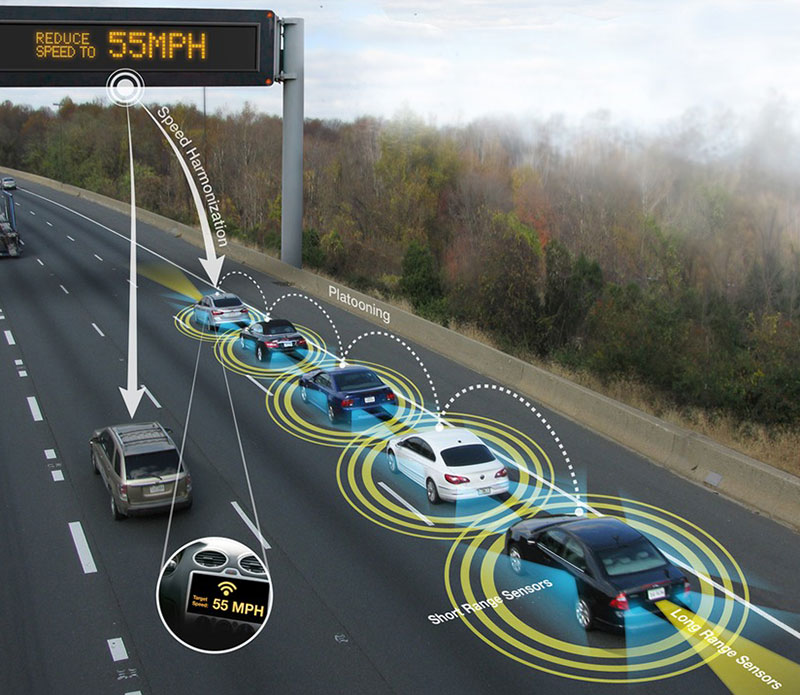
Since ACC directly controls your vehicle’s speed, automakers include fail-safe mechanisms to ensure safety:
Manual override: Tapping the brake or accelerator immediately deactivates the system.
Self-diagnostics: If a sensor malfunctions (e.g., due to dirt or weather), the system alerts the driver and disables ACC.
Multiple sensors: Redundancy in radar and cameras ensures that the system continues functioning even if one component fails.
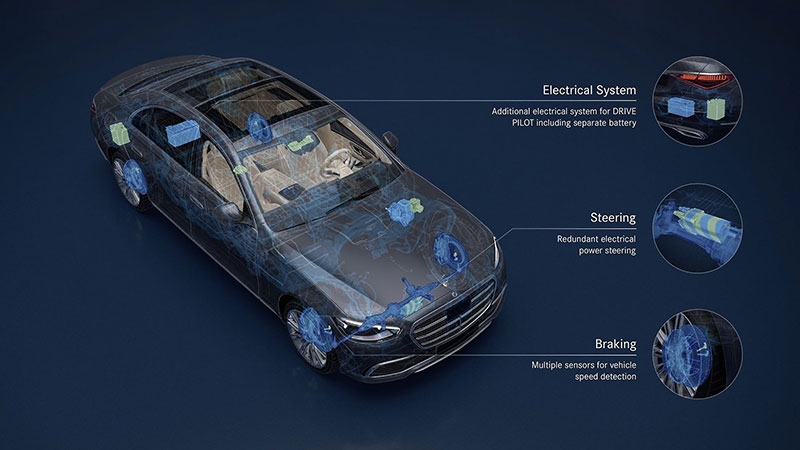
At its core, Adaptive Cruise Control (ACC) is a collaborative effort between sensors, processors, and actuators, all working together to automate one of the most repetitive tasks in driving: maintaining speed and following distance.
Unlike traditional cruise control, which only holds your speed steady, adaptive cruise control actively adjusts your speed based on real-time traffic conditions—speeding up, slowing down, and even stopping automatically, all while keeping a safe distance from the vehicle in front.
Let’s walk through exactly how this system works step-by-step, and how each key component plays its role in the process:
When you activate ACC and set your desired speed, the system immediately begins scanning the road ahead using radar sensors and a forward-facing camera.
Radar sensors, typically mounted in the front bumper or grille, emit millimeter-wave signals that bounce off objects in front of the vehicle.
These radar waves detect the distance and relative speed of the vehicle ahead—accurately and even in bad weather.
Forward-facing cameras, located behind the windshield, provide visual recognition of cars, lane markings, and obstacles. They help classify what’s being detected (e.g., a car vs. a traffic sign or roadside barrier).
These two systems work in tandem to build a real-time picture of the driving environment.
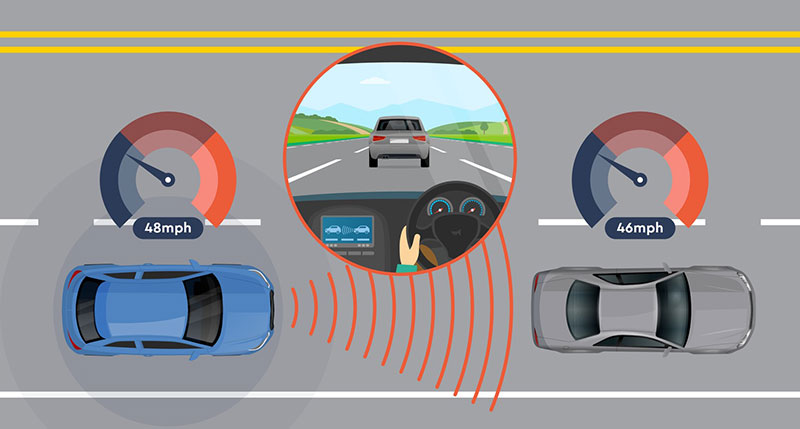
Once the radar and camera detect a lead vehicle, the information is sent to the Electronic Control Unit (ECU)—the “brain” of the ACC system.
The ECU uses algorithms to analyze traffic speed, distance, and driver-selected preferences (such as the desired following gap).
It calculates how fast you’re approaching the vehicle ahead and decides whether to maintain speed, slow down, or prepare to stop.
In more advanced systems, the ECU may also integrate data from other ADAS features (like lane-keeping or blind-spot monitoring) to enhance decision-making.
Once a decision is made, the ECU sends commands to actuators that directly control your car’s movement:
The electronic throttle is used to maintain or increase speed when the road ahead is clear.
If the system detects slower-moving traffic, it sends signals to the brake actuators, gently slowing the car to match the flow.
In stop-and-go traffic, many ACC systems can even bring the vehicle to a complete stop, and then automatically resume when traffic starts moving again (often called “full-range ACC”).
All of this happens without the driver needing to touch the pedals.
Despite being semi-autonomous, ACC always leaves room for driver control. Using steering wheel controls, the driver can:
Set the cruise speed.
Choose from different following distance intervals (e.g., 1, 2, or 3 seconds behind the car in front).
Instantly override the system by pressing the accelerator or brake pedal, which disengages the automatic control.
In vehicles with adaptive driving modes, ACC may also adjust its behavior based on the selected profile (e.g., Eco, Comfort, Sport).
In newer or upcoming models, adaptive cruise control is evolving with Vehicle-to-Vehicle (V2V) and Vehicle-to-Infrastructure (V2I) technologies:
V2V allows your car to exchange speed and braking data with other vehicles ahead—even before they appear in your field of view—for earlier reactions.
V2I communicates with smart traffic systems (e.g., stoplights or construction zones), enabling proactive speed adjustments for smoother driving and better fuel economy.
These technologies will make ACC even more predictive and efficient as infrastructure evolves.
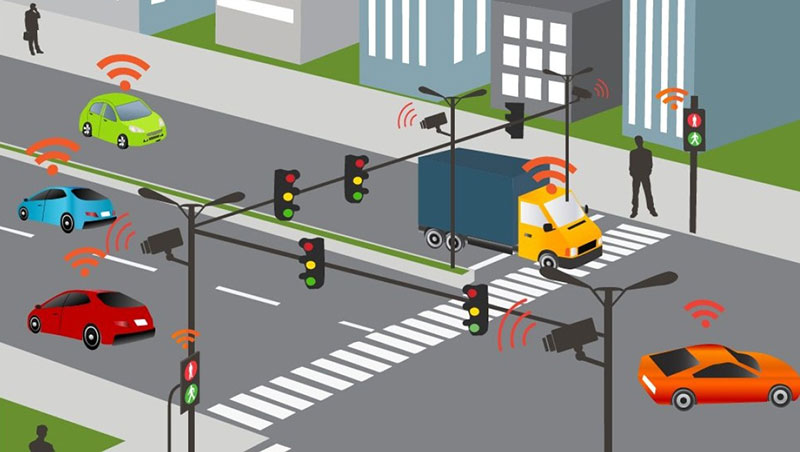
Because ACC affects critical driving functions, safety is prioritized with multiple fail-safe mechanisms:
If a sensor is blocked (by mud, snow, or ice), the system will notify the driver and disengage.
Drivers can override at any time for safety or comfort.
Some cars include redundant radar and camera systems, ensuring reliability even if one component fails.
*Summary: A Real-Time Loop of Awareness and Action
Here’s a simplified version of how ACC works in continuous real-time:
Scan: Radar and cameras monitor traffic ahead.
Analyze: ECU interprets the environment and traffic flow.
React: Throttle and brake actuators adjust your vehicle’s speed.
Adapt: System responds to traffic changes or driver inputs.
Repeat: The loop continues as long as ACC is active.
While both Adaptive Cruise Control (ACC) and Traditional Cruise Control (TCC) aim to make highway driving more convenient, the level of intelligence, safety, and automation they offer is vastly different. Think of traditional cruise control as the original calculator—and adaptive cruise control as the smart assistant that not only does the math but also anticipates your next question.
Let’s take a closer look at how these systems compare:
Traditional Cruise Control (TCC) has been around for decades and is still found in many vehicles today. It’s a relatively simple system that allows the driver to:
Set and maintain a constant speed without using the accelerator.
Resume a previously set speed after braking or canceling.
Cancel the system manually by pressing the brake or clutch.
While this feature can reduce foot fatigue on long trips, it has no awareness of traffic. If the car in front of you slows down, you have to manually brake, cancel, or adjust your speed—which defeats the purpose of “cruise” in busy traffic.
Adaptive Cruise Control (ACC) builds upon traditional cruise control by adding a powerful layer of automation and real-time environmental awareness. It not only maintains your speed but also:
Automatically adjusts speed based on the flow of traffic.
Monitors vehicles ahead using radar and cameras.
Maintains a safe following distance, which the driver can customize.
Brakes and accelerates automatically, even coming to a complete stop and resuming in traffic (in advanced systems).
ACC is essentially a “self-regulating speed system” that can adapt to changing traffic conditions without constant driver input. It enhances both comfort and safety, especially on congested highways.
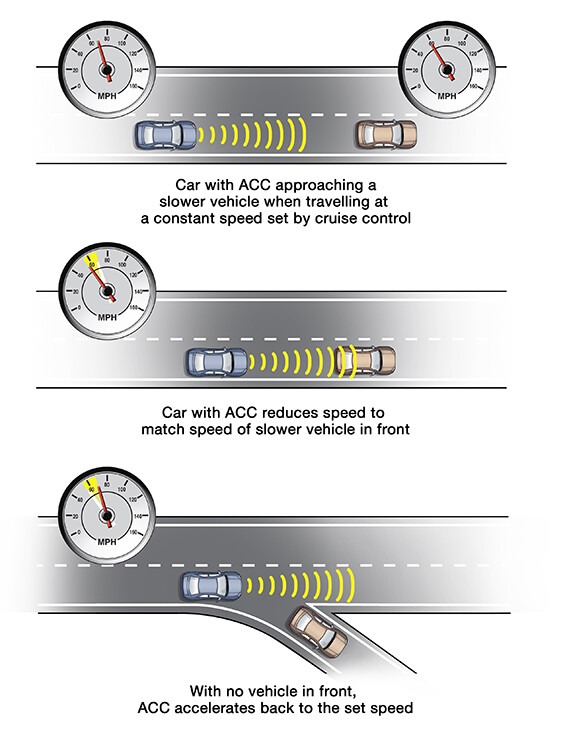
Side-by-Side Comparison Table:
| Feature | Traditional Cruise Control | Adaptive Cruise Control |
|---|---|---|
| Maintains set speed | ✅ | ✅ |
| Adjusts speed for traffic | ❌ | ✅ |
| Uses radar/camera sensors | ❌ | ✅ |
| Can stop and resume | ❌ | ✅ (in advanced versions) |
| Comfort in heavy traffic | ❌ | ✅ |
In short:
Traditional cruise control = static speed hold.
Adaptive cruise control = dynamic, responsive, and smarter driving.
Adaptive Cruise Control (ACC) isn’t a one-size-fits-all feature. In fact, depending on the vehicle manufacturer, model year, and technology level, there are several types of ACC systems—each offering different levels of automation, performance, and comfort.
Understanding these types will help you make an informed choice when shopping for a car or considering an upgrade. Let’s break them down:
This is the entry-level version of ACC and is often found in mid-range vehicles.
Core features:
Maintains a set cruising speed.
Uses radar and/or cameras to detect vehicles ahead.
Automatically adjusts speed to maintain a predefined following distance.
Braking and acceleration are mild and limited, often meant for highway use only.
Limitations:
Typically does not work below ~25 mph, so it’s ineffective in stop-and-go traffic.
May disengage below a certain speed, requiring driver input.
Example vehicles: Early Toyota/Lexus models with Dynamic Radar Cruise Control, older Ford ACC systems.
This is a more advanced system designed to handle low-speed traffic and urban congestion in addition to highway cruising.
Core features:
All functions of basic ACC, plus:
Can bring the car to a complete stop behind slower traffic.
Automatically resumes driving when traffic starts moving again (usually within a few seconds).
Works seamlessly from 0 to highway speeds.
Ideal for:
Daily commuters
Drivers in congested urban environments
Long-distance highway driving with intermittent traffic
Example vehicles: Honda Sensing, BMW’s Active Cruise Control with Stop & Go, Mercedes-Benz DISTRONIC PLUS, Audi Adaptive Cruise Assist.
This next-gen ACC leverages GPS navigation data, 3D maps, and cloud connectivity to predict driving conditions ahead—even if no vehicle is in front.
Key advantages:
Adjusts speed proactively for:
Curves
Roundabouts
Intersections
Speed limits or known speed zones (e.g., school zones)
Works in combination with lane-keeping assist and other ADAS features for smoother driving.
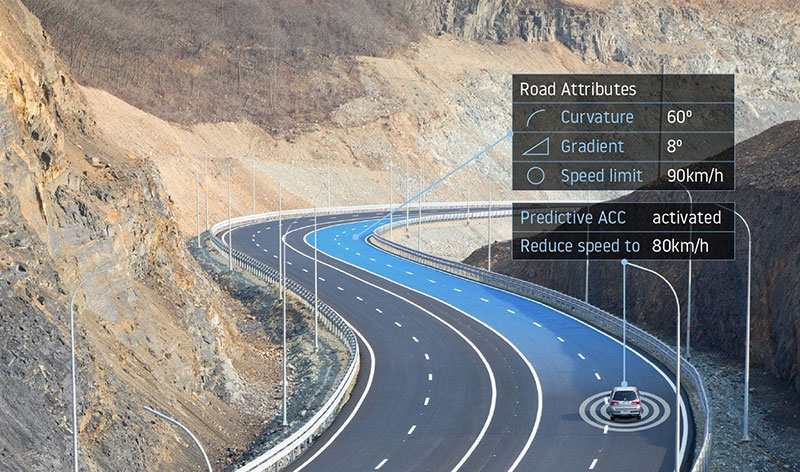
Also called:
Predictive Cruise Control (Volkswagen, Audi)
Intelligent Cruise Control (Nissan, Infiniti)
Benefit: A more fuel-efficient and smoother ride, with fewer abrupt speed changes.
This is an emerging type of ACC designed for future-ready vehicles that support Vehicle-to-Vehicle (V2V) and Vehicle-to-Infrastructure (V2I) communication.
Key features:
Receives real-time data from:
Other vehicles ahead (even beyond line of sight)
Smart traffic lights, road signs, and construction zones
Improves reaction time and anticipates braking long before the driver or sensors would typically detect an issue.
Still in development, but being tested in smart cities and autonomous fleets.
Examples: Some Cadillac models (with Super Cruise), Tesla Autopilot (when combined with Full Self-Driving beta), certain Hyundai/Kia models using HD mapping.
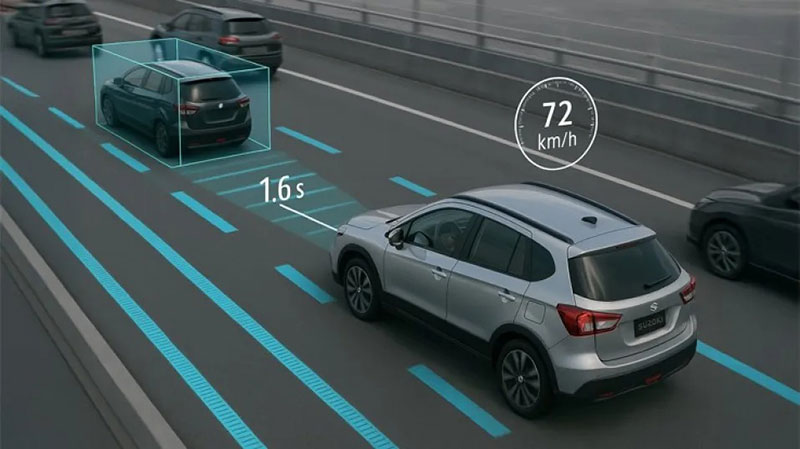
This type of ACC is semi-autonomous and combines adaptive cruise control with active steering assistance, allowing for limited hands-off driving in certain conditions.
What it does:
Maintains speed and distance plus keeps the car centered in its lane.
Often branded as:
Pilot Assist (Volvo)
ProPILOT Assist (Nissan)
Travel Assist (Volkswagen)
Highway Driving Assist (Hyundai/Kia)
Important note: These systems still require driver attention and hands on the wheel periodically, but they reduce workload significantly on long trips.
Adaptive Cruise Control (ACC) offers a smarter, safer, and more comfortable driving experience. Here are its key benefits:
Enhanced Safety: Automatically maintains a safe distance from the car ahead, reducing the risk of rear-end collisions.
Reduced Driver Fatigue: Minimizes the need for constant braking and acceleration, especially on long trips or in traffic.
Improved Fuel Efficiency: Smooth driving behavior helps lower fuel consumption by avoiding sudden speed changes.
Convenience in Traffic: Stop-and-go ACC handles slow-moving traffic with ease, making commutes less stressful.
Supports Semi-Autonomous Driving: Forms the foundation for advanced driver assistance features and future self-driving technology.
While Adaptive Cruise Control (ACC) has become one of the most appreciated driver-assist features in modern vehicles, it’s not perfect. Despite its benefits in enhancing safety and comfort, ACC comes with several inherent limitations and real-world challenges that every driver should be aware of.
ACC relies heavily on radar sensors and cameras, which can be affected by:
Heavy rain or snow: Water droplets or snowflakes can scatter radar waves, reducing detection accuracy.
Fog or bright sunlight: May interfere with the forward-facing camera’s ability to recognize vehicles or road markings.
Mud, ice, or dirt: If sensors are covered, the system may temporarily shut down or display warnings.
*Typical dashboard message: “Adaptive Cruise Control Unavailable — Clean Radar Sensor.”
*Solution: Regularly clean your front bumper, grille, and windshield to maintain sensor visibility.

You may also like:
ACC is best at detecting moving vehicles traveling in the same lane. It struggles in scenarios such as:
Suddenly stopped vehicles: If the car ahead is at a full stop (e.g., traffic jam, red light), some systems may not react in time.
Sudden lane changes: If another vehicle cuts into your lane quickly, the system may respond late.
Non-vehicular obstacles: Objects like cones, bicycles, or fallen branches may go undetected.
This is due to the system’s effort to reduce false positives, but it can result in delayed braking or no braking at all in certain edge cases.
ACC is designed primarily for highway and freeway driving, where traffic flow is consistent. In city environments, it may become less reliable due to:
Frequent stops and starts
Pedestrians, cyclists, and parked cars
Sharp corners and narrow lanes
Merging traffic and roundabouts
Some ACC systems will deactivate below certain speeds or when the road conditions become too complex.
Not all adaptive cruise systems are created equal. Depending on the brand and vehicle model, performance and comfort can vary greatly.
Premium brands (e.g., Mercedes-Benz, Audi, BMW) typically offer smoother acceleration/deceleration, better traffic handling, and enhanced predictive logic.
Basic or entry-level systems may feel jerky, lag in response time, or maintain an awkwardly large or small following distance.
This inconsistency means your experience with ACC can differ drastically between vehicles.
In some cases, drivers report unexpected behavior, such as:
False collision alerts due to shadows, road signs, or harmless objects.
Sudden disengagement of ACC due to sensor errors or temporary system malfunctions.
Radar misalignment after minor collisions or improper bumper repairs, which may cause incorrect readings.
Example: After a windshield replacement, the forward camera may need recalibration before ACC works again.
=> If you need recalibration support, you can contact AutoExplain via WhatsApp +1(936)2896695 for quick support
Because ACC involves specialized hardware and software, repairs and maintenance can be expensive.
Radar sensor replacement: $500 to $2,000 depending on the car brand.
Camera recalibration (e.g., after a windshield replacement): $200–$600.
Software updates or diagnostics: Often require dealership tools or proprietary scan tools.
Insurance premiums may also rise due to the higher cost of repairing vehicles equipped with advanced driver assistance systems.
Perhaps the most dangerous limitation is psychological: when drivers begin to trust the system too much.
ACC can lead to reduced alertness, especially on long drives.
Drivers may assume the car will react to all dangers—but ACC has limitations and blind spots.
In emergencies, delayed human reaction time could lead to an accident.
*Important note: ACC is not a fully autonomous driving feature. The driver must remain attentive and ready to intervene at all times.
Summary Table: Common Limitations at a Glance
| Problem Area | Description |
|---|---|
| Sensor Issues | Weather, dirt, or obstructions can disable the system. |
| Stationary Objects | May not detect stopped vehicles or quick lane intrusions. |
| City Driving | Not ideal for dense traffic, intersections, or pedestrian areas. |
| Inconsistent Quality | Performance varies widely by vehicle brand and model. |
| System Errors | False alerts, sudden deactivations, and radar misalignments. |
| Repair Costs | High maintenance and recalibration expenses. |
| Driver Complacency | Over-trust can lead to delayed reaction or accidents. |
Adaptive cruise control is not a substitute for attentive driving. The system assists the driver but doesn’t replace their responsibilities.
Best Practices:
Always keep hands on the wheel (unless equipped with hands-free driving systems).
Don’t rely on ACC in complex urban environments.
Monitor for any sensor malfunctions or warning lights.
ACC is a stepping stone toward full autonomy. It’s part of SAE Level 1–2 automation, and it’s already helping pave the way for more sophisticated systems like:
Traffic Jam Pilot
Highway Assist
Hands-Free Driving (GM Super Cruise, Ford BlueCruise, Tesla FSD Beta)
As vehicle technology advances, future ACC systems may incorporate:
AI-based driver behavior prediction
Vehicle-to-vehicle (V2V) communication
Integration with real-time map and traffic data
You frequently drive on highways
You endure long commutes with traffic congestion
You want added peace of mind and convenience
You mostly drive in cities at low speeds
Your budget is very limited and your car doesn’t support upgrades
However, as the tech becomes standard on more vehicles, you may find that it’s now affordable and worth the investment.
11.1. Is adaptive cruise control safe?
Yes—when used properly. It enhances safety by helping maintain distance, but it still requires driver attention.
11.2. Can ACC be turned off?
Yes, most vehicles allow you to turn it off and use standard cruise control or drive manually.
11.3. Does it work in the rain or snow?
Not always. Bad weather can obscure sensors, so the system may temporarily disengage.
11.4. Can I retrofit ACC on an older car?
It’s very difficult and usually not practical due to the required sensors, software, and calibration.
11.5. Will it brake automatically to prevent accidents?
ACC will slow or stop the car to avoid collision in many cases, but it’s not a full emergency braking system. Use caution.
Adaptive Cruise Control is one of the most impactful technologies in modern driving. By blending speed control with automatic distance management, it improves safety, reduces stress, and makes long drives more pleasant.
Whether you’re considering it for your next vehicle or just want to understand how your current system works, knowing the ins and outs of adaptive cruise control helps you drive smarter.
If your adaptive cruise control system is malfunctioning or showing warning lights, it may need sensor recalibration, diagnostic checks, or software updates. Our team at AutoExplain offers expert remote diagnostics for vehicles including Mercedes-Benz, BMW, Audi, Toyota, and more.
📲 Contact us for remote support via:
WhatsApp: +1 (936) 289-6695
Gmail: [email protected]
Let’s get your smart systems working smarter!


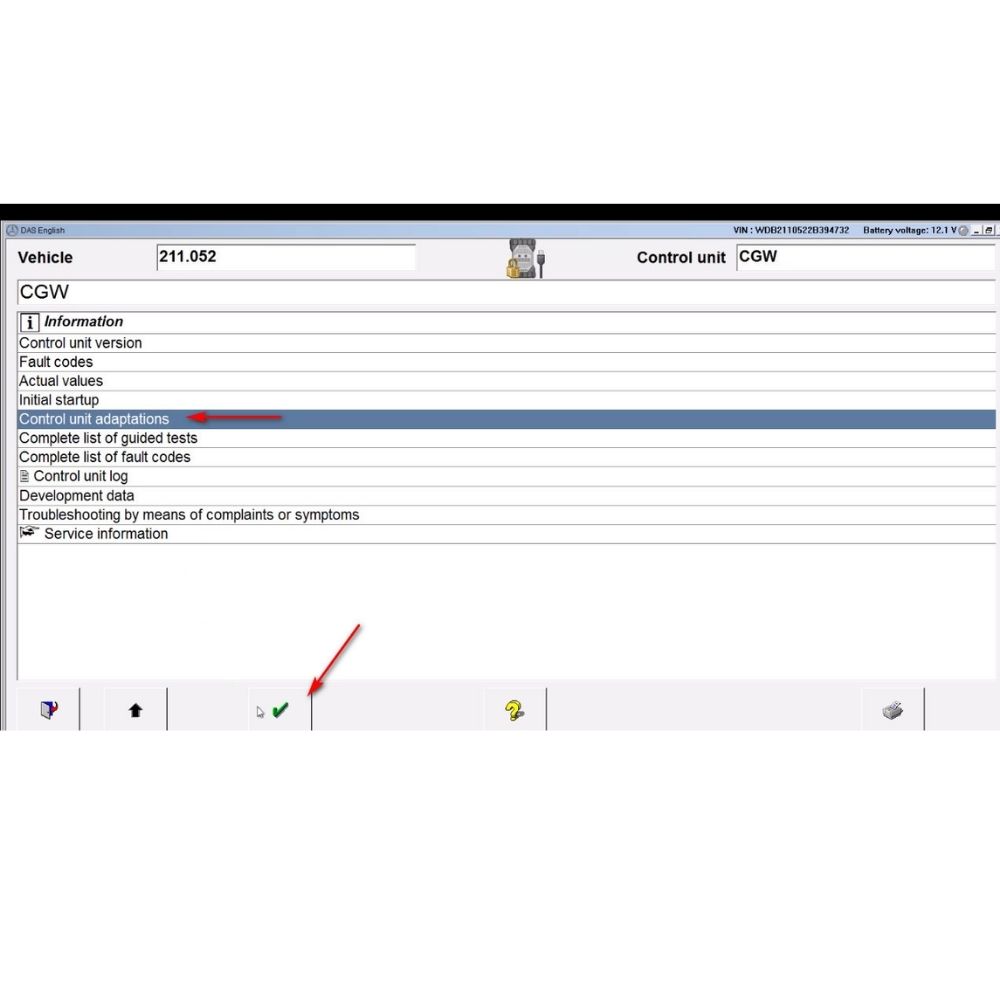
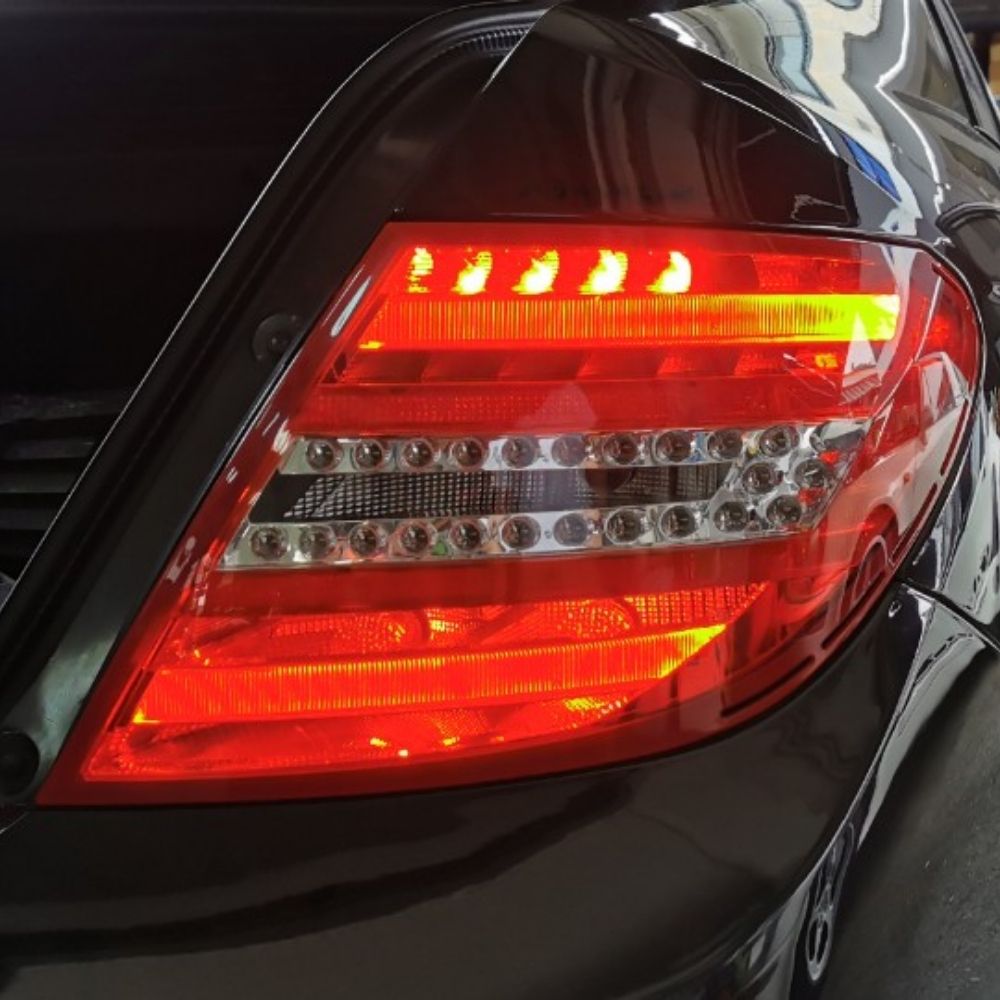

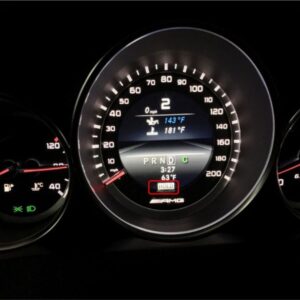
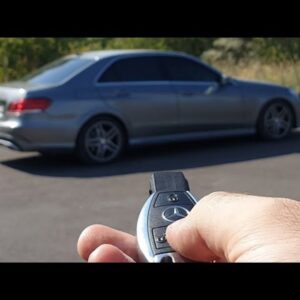

At AutoExplain, we provide automotive online repair service, auto repair tips, car repair manuals & document & training course to help mechanics of all experience levels—fix vehicles efficiently
AUTO EXPLAIN LLC
Employer Identification Number (EIN):
38-4349958
Whatsapp Us: +1(936)2896695
Gmail: [email protected]
Our Workshop: 1500 N Grant ST Sten Denver, Colorado, United States
Copyright 2025 © AutoExplain